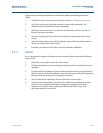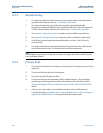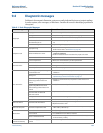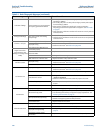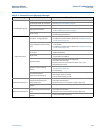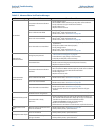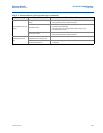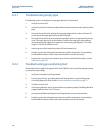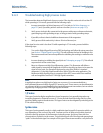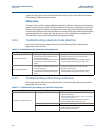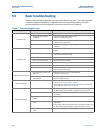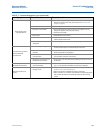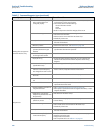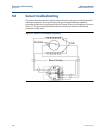
159
Reference Manual
00809-0100-4444, Rev AC
Section 9: Troubleshooting
January 2015
Tro ubles hooting
9.4.3 Troubleshooting high process noise
The transmitter detected high levels of process noise. If the signal to noise ratio is less than 25
while operating in 5 Hz mode, proceed with the following steps:
1. Increase transmitter coil drive frequency to 37 Hz (refer to Coil drive frequency on
page 131) and, if possible, perform auto zero function (Auto zero on page 131).
2. Verify sensor is electrically connected to the process with process reference electrode,
grounding rings with grounding straps, or lining protector with grounding straps.
3. If possible, redirect chemical additions downstream of the magmeter.
4. Verify process fluid conductivity is above 10 microSiemens/cm.
If the signal to noise ratio is less than 25 while operating in 37 Hz mode, proceed with the
following steps:
1. Turn on the Digital Signal Processing (DSP) technology and follow the setup procedure
(see Section 7 Digital Signal Processing). This will minimize the level of damping in the
flow measurement and control loop while also stabilizing the reading to minimize valve
actuation.
2. Increase damping to stabilize the signal (refer to PV damping on page 37). This will add
response time to the control loop.
3. Move to a Rosemount High-Signal flowmeter system. This flowmeter will deliver a
stable signal by increasing the amplitude of the flow signal by ten times to increase the
signal to noise ratio. For example if the signal to noise ratio (SNR) of a standard
magmeter is 5, the High-Signal would have a SNR of 50 in the same application. The
Rosemount High-Signal system is comprised of the 8707 sensor which has modified
coils and magnetics and the 8712H High-Signal transmitter.
Note
In applications where very high levels of noise are a concern, it is recommended that a
dual-calibrated Rosemount High-Signal 8707 sensor be used. These sensors can be calibrated to
run at lower coil drive current supplied by the standard Rosemount transmitters, but can also be
upgraded by changing to the 8712H High-Signal transmitter.
1/f noise
This type of noise has higher amplitudes at lower frequencies, but generally degrades over
increasing frequencies. Potential sources of 1/f noise include chemical mixing and slurry flow
particles rubbing against the electrodes. This type of noise can be mitigated by switching to the
37Hz coil drive frequency.
Spike noise
This type of noise generally results in a high amplitude signal at specific frequencies which can
vary depending on the source of the noise. Common sources of spike noise include chemical
injections directly upstream of the flowmeter, hydraulic pumps, and slurry flows with low
concentrations of particles in the stream. The particles bounce off of the electrode generating a
“spike” in the electrode signal. An example of this type of flow stream would be a recycle flow in



